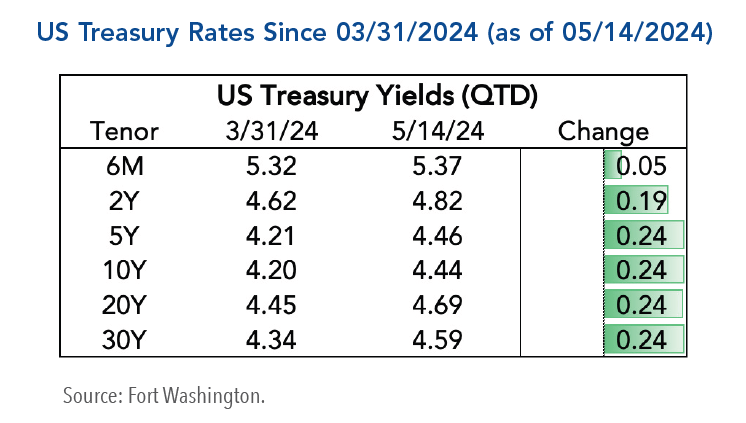Highlights
- Given historically tight spreads and uncertainty around continued economic growth, we are positioning portfolios with a modest amount of risk.
- Changing expectations for Fed policy continues to drive markets.
- This year's robust growth and labor market support a no-landing scenario, but there are conflicting data points that suggest downside risks remain.
- Investors have become cautious about the potential for inflation to remain persistent, as recent inflation figures have slowed the downward trajectory toward 2%.
Economic Outlook
The prospects for a no landing, or at least a soft landing, have increased in likelihood given recent economic data. However, there are conflicting signals for the market such as the lower average workweek and the reduction of temporary workers. Both of these data series are below pre-covid levels and indicate companies are working to protect margins.
The economy has been able to grow above trend with the help of additional fiscal spending during the pandemic. As that support is no longer abundant and consumers have largely spent excess savings from pandemic-era programs, consumer spending appears poised to slow from the current pace.
In aggregate, we expect the economy to continue slowing, which will soften the labor market. This weakening in the labor market should put downward pressure on wage growth and, subsequently, inflation.
Inflation
Investors remain focused on the path of inflation and have become wary following recent inflation reports that were higher than expected. Despite the uptick in inflation, we believe that the larger path remains in place and expect inflation to continue cooling.
- Shelter data has defied leading indicators recently. However, new tenant leases, sourced from the BLS similar to CPI data, show a path lower for shelter over the coming months. Excluding shelter, year-over-year CPI has been around 2% since mid-2023.
- It’s important to note that inflation within discretionary sectors is well behaved but it is non-discretionary spending, even excluding shelter, where inflation is well above target.
Following higher-than-expected inflation reports, and strong economic data, investors have reduced their expectations for rate cuts relative to the start of the year. Current forecasts are for about 2 cuts through the rest of 2024.
- Given recent data surrounding growth and the labor market, we believe market expectations for 2 cuts are appropriate.
- Our view is that the odds of a near-term rate hike are remote.
Multi-Sector Positioning
In our multi-sector fixed income portfolios, we decreased the risk budget target from 40% to 30%, positioning for a moderate overweight to risk. Markets are pricing in a high probability for a soft/no landing, resulting in spreads at historically tight levels with risk/reward skewed to the downside.
Fixed income portfolios continue to be managed neutral duration with the expectation of opportunities for tactical adjustments as the market adjusts its expectations for the Federal Reserve’s policy. From a key rate perspective, portfolios are positioned for the yield curve to steepen.
- The strategy has lengthened its duration following the increase in rates this year and is targeting a level of around 5-5.5 years. The strategy continues to target HY credit exposure around 10% (near the lower end of the historical range), as spreads remain tight.
- Conviction positions include BBB rated subordinated banking, Emerging Markets Debt high yield, and non-agency ABS/CLO/CMBS. Recently exited subordinated utility holdings following strong performance.
- Core Plus has maintained credit risk so far in 2024 with the most meaningful adjustments being tactical interest rate management as rates exhibit volatility.
- The strategy recently eliminated the majority of its allocation to Emerging Market Debt following strong performance and historically tight spreads in the sector. The strategy continues to favor non-agency securitized sectors (i.e. ABS/CLO/CMBS/RMBS).
- The strategy has maintained credit risk during the year, but recently eliminated exposure to TIPS following a rise in inflation expectations throughout April.
- The strategy is maintaining overweight allocations to investment grade corporates and CMBS.
- The strategy has maintained credit risk during the year, but recently eliminated exposure to TIPS following a rise in inflation expectations throughout April.
- Structured products are underweight due to lower exposure to Agency RMBS, but at a more detailed level, we are maintaining the overweight to high quality non-agency CMBS.
Single Sector Positioning
- The strategy has a modest overweight to risk relative to the index, but overall risk levels continue to be decreased in favor of higher quality issuers with good liquidity.
- Technicals for the sector are generally positive as supply is expected to decrease, average dollar prices are low, and nominal yield buyers remain robust.
- The strategy’s high conviction issuers include subordinated financials and BBB rated industrials while looking for opportunities in cyclicals and technology on weakness.
Securitized Products
- We continue to favor non-agency exposure with an underweight to Agency RMBS. Despite meaningful spread tightening across much of the non-agency space this year, there are still pockets of attractive relative value such as high quality non-agency RMBS (especially discount prime jumbo 2.0).
- The strategy has biased credit quality given the spread between tranches (AAA, AA, etc.,) has flattened and investors are not being compensated to take on additional credit risk.
- EMD has maintained a modest overall credit risk profile (30%-40% of maximum spread beta budget) over the past few months. High yield continues to be favored over investment grade issuers even as spreads have tightened, limiting the opportunity set.
- The team is finding value in distressed names, countries with improving fundamentals, and corporates with solid financials that are lagging behind their respective sovereigns.
- Key risks to the outlook include negative growth or inflation surprises, and escalation in global hotspots such as the Middle East.
- Portfolio activity is focused on maintaining a higher quality bias and a preference for less cyclical exposure as spreads are near historically tight levels.
- Default activity has stabilized, albeit at an elevated level, but we do not anticipate relief in the near term. Consequentially, we do not believe investors are being compensated for the downside risk of increasing defaults.
Market Performance
Rates have moved higher so far in Q2 as investors adjusted their expectations for rate cuts. The 10-year Treasury is up around 24bps and the curve has steepened marginally.
Credit spreads have been generally range-bound and remain near historically tight levels.
The Bloomberg US Aggregate Index is down ~0.83% through May 14th, driven primarily by rates.



Download Mid-Quarter Fixed Income Update – 2Q 2024
Download Mid-Quarter Fixed Income Update – 2Q 2024




































